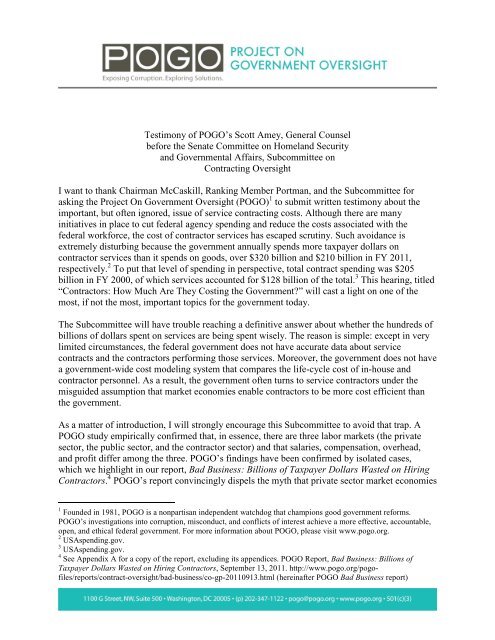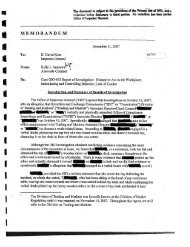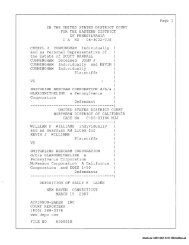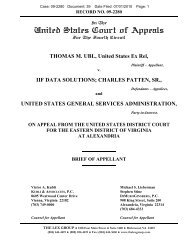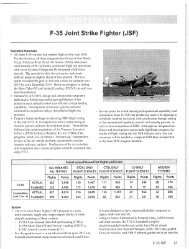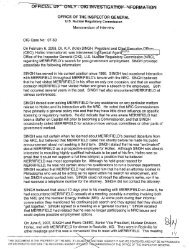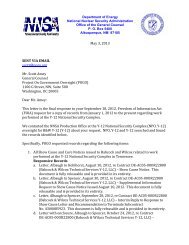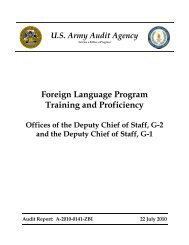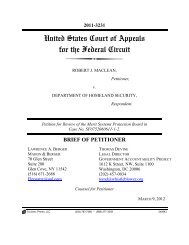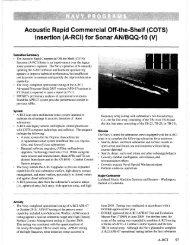SA McCaskill Cost Hearing Final 03 29 12 - U.S. Senate Homeland ...
SA McCaskill Cost Hearing Final 03 29 12 - U.S. Senate Homeland ...
SA McCaskill Cost Hearing Final 03 29 12 - U.S. Senate Homeland ...
You also want an ePaper? Increase the reach of your titles
YUMPU automatically turns print PDFs into web optimized ePapers that Google loves.
Testimony of POGO’s Scott Amey, General Counsel<br />
before the <strong>Senate</strong> Committee on <strong>Homeland</strong> Security<br />
and Governmental Affairs, Subcommittee on<br />
Contracting Oversight<br />
I want to thank Chairman <strong>McCaskill</strong>, Ranking Member Portman, and the Subcommittee for<br />
asking the Project On Government Oversight (POGO) 1 to submit written testimony about the<br />
important, but often ignored, issue of service contracting costs. Although there are many<br />
initiatives in place to cut federal agency spending and reduce the costs associated with the<br />
federal workforce, the cost of contractor services has escaped scrutiny. Such avoidance is<br />
extremely disturbing because the government annually spends more taxpayer dollars on<br />
contractor services than it spends on goods, over $320 billion and $210 billion in FY 2011,<br />
respectively. 2 To put that level of spending in perspective, total contract spending was $205<br />
billion in FY 2000, of which services accounted for $<strong>12</strong>8 billion of the total. 3 This hearing, titled<br />
“Contractors: How Much Are They <strong>Cost</strong>ing the Government?” will cast a light on one of the<br />
most, if not the most, important topics for the government today.<br />
The Subcommittee will have trouble reaching a definitive answer about whether the hundreds of<br />
billions of dollars spent on services are being spent wisely. The reason is simple: except in very<br />
limited circumstances, the federal government does not have accurate data about service<br />
contracts and the contractors performing those services. Moreover, the government does not have<br />
a government-wide cost modeling system that compares the life-cycle cost of in-house and<br />
contractor personnel. As a result, the government often turns to service contractors under the<br />
misguided assumption that market economies enable contractors to be more cost efficient than<br />
the government.<br />
As a matter of introduction, I will strongly encourage this Subcommittee to avoid that trap. A<br />
POGO study empirically confirmed that, in essence, there are three labor markets (the private<br />
sector, the public sector, and the contractor sector) and that salaries, compensation, overhead,<br />
and profit differ among the three. POGO’s findings have been confirmed by isolated cases,<br />
which we highlight in our report, Bad Business: Billions of Taxpayer Dollars Wasted on Hiring<br />
Contractors. 4 POGO’s report convincingly dispels the myth that private sector market economies<br />
1<br />
Founded in 1981, POGO is a nonpartisan independent watchdog that champions good government reforms.<br />
POGO’s investigations into corruption, misconduct, and conflicts of interest achieve a more effective, accountable,<br />
open, and ethical federal government. For more information about POGO, please visit www.pogo.org.<br />
2<br />
U<strong>SA</strong>spending.gov.<br />
3<br />
U<strong>SA</strong>spending.gov.<br />
4<br />
See Appendix A for a copy of the report, excluding its appendices. POGO Report, Bad Business: Billions of<br />
Taxpayer Dollars Wasted on Hiring Contractors, September 13, 2011. http://www.pogo.org/pogofiles/reports/contract-oversight/bad-business/co-gp-20110913.html<br />
(hereinafter POGO Bad Business report)
necessarily allow contractors to perform government services at a cost savings to the<br />
government. The reality is that there are no generalizations that withstand scrutiny as to which<br />
market sector provides the optimal cost efficiency for any service area, no less all service areas.<br />
As a result, the federal government must, on a case-by-case basis, analyze whether it is more<br />
appropriate and cost efficient to employ government or contractor employees.<br />
The purpose of this hearing is to examine whether and how cost information is used by<br />
government agencies to make decisions about whether work should be performed by federal<br />
employees or contractors. Throughout this testimony, I will expand on the lack of personnel and<br />
cost data and what needs to be done to improve the system. POGO truly believes that if simple<br />
fixes are made, the government will save billions of dollars without expanding or reducing the<br />
size of the total federal workforce, which includes government and contractor employees.<br />
Today, witnesses will likely testify about two comparative cost models that are currently used to<br />
determine whether it is less costly to have private contractors perform government services,<br />
OMB Circular A-76 and the Defense Department’s Directive-Type Memorandum (DTM) 09-<br />
007, “Estimating and Comparing the Full <strong>Cost</strong>s of Civilian and Military Manpower and Contract<br />
Support.” 5 Those models are utilized, however, in only a small percentage of cases where the<br />
government contracts for services. In a vast majority of those instances, the models demonstrated<br />
that contractors were unable to accord any savings; indeed, were the government to transfer<br />
government services to contractors, the government would incur excessive costs. But even these<br />
models have been the subject of criticism for their failure to provide the government with an<br />
effective cost modeling system that accurately reflects all the relevant cost factors. 6 Because it<br />
does not approach the state-of-the-art systems employed by sophisticated business enterprises,<br />
the government limits its ability to make competent human capital planning decisions.<br />
I hope that this written testimony provides the Subcommittee with useful information about the<br />
government’s current inability to evaluate service contracting costs. More importantly, I hope<br />
this testimony will make clear what is missing in the current system and how to begin rectifying<br />
systematic flaws that cost taxpayers billions of dollars each year. So much is unknown about the<br />
true size and cost of both the government and contractor workforce. Congress must pass<br />
legislation that will create an effective government-wide cost modeling system and overhaul<br />
5 Federal law requires that the “Secretary of Defense shall use the least costly form of personnel consistent with<br />
military requirements and other needs of the Department,” which includes considering converting work from<br />
military, civilian, or private contract. 10 U.S.C. 1<strong>29</strong>a. http://uscode.house.gov/uscodecgi/fastweb.exe?getdoc+uscview+t09t<strong>12</strong>+75+1++%28%<strong>29</strong>%20%20AND%20%28%2810%<strong>29</strong>%20ADJ%20USC%2<br />
9%3ACITE%20AND%20%28USC%20w%2F10%20%281<strong>29</strong>a%<strong>29</strong>%<strong>29</strong>%3ACITE<br />
6 Congressional Research Service, Defense Outsourcing: The OMB Circular A-76 Policy (RL3<strong>03</strong>92), June 30, 2005,<br />
pp. 4-6. http://www.fas.org/sgp/crs/natsec/RL3<strong>03</strong>92.pdf (Downloaded April 20, 2011); In addition, a Center for<br />
Strategic and International Studies (CSIS) report highlights the inherent problems with government life-cycle cost<br />
comparison models and appropriate overhead rates, and proposed a cost-estimating methodology. Although the<br />
report discusses a comprehensive cost estimation methodology that should be used to create a baseline for making<br />
more accurate cost comparisons, it is silent on all the costs the government incurs, above and beyond fixed billing<br />
rates, associated with the award, administration, and oversight of service contracts. Center for Strategic and<br />
International Studies, DoD Workforce <strong>Cost</strong> Realism Assessment, May 2011, pp. 11-19.<br />
http://csis.org/files/publication/110517_Berteau_DoDWorkforce<strong>Cost</strong>_Web.pdf (Downloaded May 18, 2011)<br />
(hereinafter DoD Workforce <strong>Cost</strong> Realism Assessment)<br />
2
service contract inventories. 7 Such legislation will enable decision makers to identify costly<br />
service contracts and provide agencies with the tools necessary to avoid transferring government<br />
services to contractors at unjustifiable costs.<br />
Service Contracting Myths<br />
POGO has watched federal contract award dollars dramatically increase from just over $200<br />
billion in FY 2000 to over $530 billion in FY 2011. 8 At the same time, service contract dollars<br />
have also been escalating at a rapid pace. There is no doubt that the increase in contract spending<br />
is the direct result of 9/11, Hurricanes Katrina, Rita, and Wilma, and the wars in Iraq and<br />
Afghanistan. However, the problem is more long-standing, and is the direct result of multiple<br />
administrations moving functions from the public to the private sector under the guise of cost<br />
savings.<br />
Both political parties have taken issue with the proper size of the federal civilian workforce and<br />
the proper balance between government employees and contractor employees. 9 Initiatives to<br />
make the government run like the private sector and shrink the size of the federal government<br />
became very popular in the 1980s and 1990s. Even today, there are calls in Congress to reduce<br />
the size of government and freeze federal employee salaries. 10<br />
The first myth of service contracting involves the notion that when the federal government<br />
outsources work to contractors, contractor employees are not part of “big government,” although<br />
many are retired federal employees, are paid with taxpayer dollars, work inside government<br />
offices, and/or perform government missions. Because they are generally not seen as part of the<br />
total government workforce, they are spared the wrath of budget hawks calling for personnel<br />
reductions and cuts in benefits. The number of contractor employees in the federal workforce is<br />
in excess of 7 million, nearly four times the size of the federal employee workforce (which is<br />
over 2 million). 11 The actual number of service contractors is, at best, an estimate, <strong>12</strong> although<br />
7 GAO found differing methodologies among the services and data was not complete. Government Accountability<br />
Office, Defense Acquisitions: Observations on the Department of Defense Service Contract Inventories for Fiscal<br />
Year 2008 (GAO-4 10-350R), January <strong>29</strong>, 2010, pp. 1-5. http://www.gao.gov/assets/100/96539.pdf (Downloaded<br />
March 27, 20<strong>12</strong>)<br />
8 According to data compiled by POGO from the Federal Procurement Data System – Next Generation and<br />
U<strong>SA</strong>spending.gov for fiscal years 2000 and 2011. http://www.usaspending.gov/<br />
9 Ed O’Keefe, “Eye Opener: <strong>Homeland</strong> Security has more contractors than feds,” The Washington Post, February<br />
24, 2010. http://voices.washingtonpost.com/federal-eye/2010/02/eye_opener_homeland_security_h.html<br />
(Downloaded September 27, 2010)<br />
10 For example, the House Budget Committee is seeking to “[b]oost private-sector employment by slowing the<br />
growth of the public sector, achieving a 10 percent reduction over the next three years in the federal workforce<br />
through attrition, coupled with a pay freeze until 2015 and reforms to government workers’ fringe benefits. House<br />
Budget Committee, The Path to Prosperity: A Blueprint for American Renewal, March 20, 20<strong>12</strong>, p. 32.<br />
http://budget.house.gov/UploadedFiles/Pathtoprosperity2013.pdf (Downloaded March 26, 20<strong>12</strong>)<br />
11 U.S. Office of Personnel Management, Federal Employment Statistics, “Historical Federal Workforce Tables:<br />
Executive Branch Civilian Employment Since 1940.”<br />
http://www.opm.gov/feddata/HistoricalTables/ExecutiveBranchSince1940.asp (Downloaded March 27, 20<strong>12</strong>)<br />
<strong>12</strong> When the contractor workforce is combined with civilians, military personnel, U.S. Postal Service employees, and<br />
grantees, the size of the blended federal workforce was estimated at 14.6 million people in 2005. Paul C. Light, The<br />
New True Size of Government, New York University, August 2006, p. 8.<br />
http://wagner.nyu.edu/performance/files/True_Size.pdf (Downloaded March 27, 20<strong>12</strong>); Paul C. Light, “The real<br />
3
there are efforts underway to improve those estimates. 13 Recent legislation designed to create<br />
inventories of service contracts and identify the precise number of contractor employees has<br />
failed to be implemented in a manner that would achieve its intent. 14 As a result, no one has a<br />
better understanding of the size of the contractor workforce today than we did before the<br />
legislation was adopted. Congress should amend the laws creating service contract inventories to<br />
mandate a full and comprehensive account of precisely how large a contractor workforce each<br />
federal agency maintains. Further, it must include all tiers of subcontractors, broken out by the<br />
types of services they provide, the billing rates the government must pay, and the costs it must<br />
incur to maintain that workforce.<br />
The second myth is that the private sector is in all ways more cost efficient, more innovative, and<br />
more flexible than the government. This supposition might be true in certain circumstances, but<br />
policymakers have been misled about promised across-the-board savings resulting from hiring<br />
service contractors. In fact, long-term service contracts (which began as short-term quick fixes)<br />
remove government flexibility and result in cost inefficiencies rather than savings over the<br />
lifetime of the contract. 15 Consequently, recent GAO reports sought to discuss areas where<br />
agencies could achieve better cost savings, but not a single report attempted to identify the<br />
government’s over-bloated reliance upon service contracts as an area for cost savings. 16 The<br />
excessive costs associated with service contracts such as those documented in POGO’s Bad<br />
Business report do not appear on the radar screen of Congress’ primary auditing and<br />
investigative organization. This institutional failure reflects the power of the aforementioned<br />
myth. Congress must bust this myth and bring focus and attention to maybe the most critical<br />
source of government waste and administrative inefficiencies.<br />
crisis in government,” The Washington Post, January <strong>12</strong>, 2010, p. A17. http://www.washingtonpost.com/wpdyn/content/article/2010/01/11/AR20100111<strong>03</strong>255.html<br />
(Downloaded March <strong>29</strong>, 2011); <strong>Hearing</strong> Statement of Paul<br />
C. Light, New York University/The Brookings Institution, before the U.S. <strong>Senate</strong> Subcommittee on Oversight of<br />
Government Management, the Federal Workforce and the District of Columbia, “An Update on the Bush<br />
Administration’s Competitive Sourcing Initiative,” July 24, 20<strong>03</strong>.<br />
http://wagner.nyu.edu//faculty/publications/files/lightCompetitiveSourcing.pdf (Downloaded September 27, 2010);<br />
Government Accountability Office, Defense Acquisitions: Observations on the Department of Defense Service<br />
Contract Inventories for Fiscal Year 2008 (GAO-10-350R), January <strong>29</strong>, 2010, pp. 2-4.<br />
http://www.gao.gov/new.items/d1<strong>03</strong>50r.pdf (Downloaded March 26, 20<strong>12</strong>)<br />
13 Government Accountability Office, OMB Service Contracts Inventory Guidance and Implementation (GAO-11-<br />
538R), May 27, 2011, p. 4. http://www.gao.gov/new.items/d11538r.pdf (Downloaded March 26, 20<strong>12</strong>)<br />
14 National Defense Authorization Act for Fiscal Year 2008 (Pub. Law 110-181), § 807(a), January 28, 2008;<br />
Consolidated Appropriations Act for FY 2010 (Pub. Law 111-117), § 743, December 16, 2009.<br />
15 For instance, the Army logistics support LOGCAP IV contract award to three different contractors has one base<br />
year and nine option years. U.S. Army Sustainment Command Public Affairs, “ASC selects LOGCAP IV<br />
contractors,” June 28, 2007. http://www.army.mil/article/3836/asc-selects-logcap-iv-contractors/ (Downloaded May<br />
31, 2011)<br />
16 Government Accountability Office, 20<strong>12</strong> Annual Report: Opportunities to Reduce Duplication, Overlap and<br />
Fragmentation, Achieve Savings, and Enhance Revenue (GAO-<strong>12</strong>-342SP), February 20<strong>12</strong>.<br />
http://www.gao.gov/assets/590/588818.pdf (Downloaded March 26, 20<strong>12</strong>); Statement of Cathleen A. Berrick,<br />
Managing Director <strong>Homeland</strong> Security and Justice Issues Government Accountability Office, “Department of<br />
<strong>Homeland</strong> Security: Actions Needed to Reduce Overlap and Potential Unnecessary Duplication, Achieve <strong>Cost</strong><br />
Savings, and Strengthen Mission Functions (GAO-<strong>12</strong>-464T),” March 8, 20<strong>12</strong>.<br />
http://www.gao.gov/assets/590/589<strong>12</strong>5.pdf (Downloaded March 27, 20<strong>12</strong>)<br />
4
An attempt by a private sector think tank to study the issue of comparative costs was flawed, as<br />
the report compared public and private sector salary or compensation and projected their findings<br />
onto the costs of transferring services to the contractor sector without a shred of evidence that<br />
such projections are valid. Indeed, such projections are both theoretically and factually flawed.<br />
Moreover, POGO is aware of a GAO study that is underway that is reviewing public and private<br />
sector pay comparability. However, it is our understanding that GAO will not address whether or<br />
how such comparisons inform the cost effectiveness of contracting for government services. 17<br />
Additionally, last year, the House Subcommittee on Federal Workforce, U.S. Postal Service, and<br />
Labor Policy held a hearing titled “Are Federal Workers Underpaid?” 18 The hearing discussed<br />
the findings of a study funded by the Heritage Foundation comparing public and private sector<br />
pay. 19 The Heritage study suffered from a number of methodological problems that call into<br />
question the validity of its findings and recommendations, including its recommendation that the<br />
government hire more contractors. 20 Despite Heritage’s claim that federal employees are<br />
compensated at higher rates than private sector employees, Heritage did not empirically<br />
determine whether or not those savings would, in fact, be realized were the government to<br />
transfer its services to the contractor sector.<br />
A recent report by the Congressional Budget Office (CBO), “Comparing the Compensation of<br />
Federal and Private-Sector Employees,” 21 also compared public and private sector pay. CBO<br />
found that, overall, “federal workers tend to be older, more educated, and more concentrated in<br />
professional occupations than private-sector workers,” and, on average, are paid 16 percent more<br />
than similar employees in the private sector. However, that trend occurs mostly in the lower<br />
education levels. Public servants with advanced degrees were paid 18 percent less in total<br />
compensation than the private sector. 22 POGO found a very similar disparity in our Bad Business<br />
report. However, our report also found that contractors cost, on average, 83 percent more than<br />
federal employees and over 100 percent more than their peers in the private sector for 35<br />
comparable occupations.<br />
17 POGO staffers have met on two occasions with GAO personnel who are conducting a congressionally requested<br />
study of public and private sector pay. “Comparability” of federal employee compensation with private sector<br />
compensation is legislatively mandated. Office of Personnel Management, “Federal Employees Pay Comparability<br />
Act of 1990”. http://www.opm.gov/feddata/html/paystructure/2004/fepca1990.asp (Downloaded March 26, 20<strong>12</strong>)<br />
18 <strong>Hearing</strong> of House Oversight and Government Reform Subcommittee on Federal Workforce, U.S. Postal Service,<br />
and Labor Policy, “Are Federal Workers Underpaid?”, March 9, 2011. http://oversight.house.gov/hearing/arefederal-workers-underpaid/<br />
19 James Sherk, A Report of the Heritage Center for Data Analysis: Inflated Federal Pay: How Americans Are<br />
Overtaxed to Overpay the Civil Service (Report # 10-05), July 7, 2010, p. 1.<br />
http://thf_media.s3.amazonaws.com/2010/pdf/CDA10-05.pdf (Downloaded September 27, 2010) (hereinafter<br />
Heritage Study). The Heritage Foundation “is a research and educational institution—a think tank—whose mission<br />
is to formulate and promote conservative public policies based on the principles of free enterprise, limited<br />
government, individual freedom, traditional American values, and a strong national defense.”<br />
http://www.heritage.org/About<br />
20 Heritage Study, p. 16.<br />
21 Congressional Budget Office, Comparing the Compensation of Federal and Private-Sector Employees, January<br />
20<strong>12</strong>. http://www.cbo.gov/sites/default/files/cbofiles/attachments/01-30-FedPay.pdf (Downloaded March 26, 20<strong>12</strong>)<br />
(hereinafter CBO Pay Study)<br />
22 CBO Pay Study, p. vii-ix.<br />
5
We should also consider the data that has been analyzed by the Office of Personnel Management<br />
(OPM). OPM data compares various occupations, including those set and adjusted in the General<br />
Schedule (GS) rates of pay, documenting that compensation for many white collar jobs is lower<br />
in the federal government than in the private sector. One example provided by OPM clearly<br />
shows that federal pay for a government engineer is lower than private sector pay. 23<br />
Studies comparing public and private sector pay are only useful for limited purposes, but they<br />
will continue to drive policy decisions until Congress mandates that cost comparisons include the<br />
aforementioned third market: contractor costs. This includes salary, full fringe benefits, all<br />
overhead to house federal and contractor employees, accurate data on contractor personnel, and<br />
fully loaded costs. Without taking the full universe of costs into account, the government risks<br />
wasting billions of dollars and jeopardizing the quality of government services. 24<br />
POGO’s Study Proves a More Complete Picture is Needed<br />
For the first time, POGO’s study introduced into discussions concerning public-private<br />
compensation the issue of costs associated with transferring government jobs to contractors.<br />
POGO compared total annual compensation for federal and private sector employees with<br />
federal contractor billing rates in order to determine whether the current costs of federal service<br />
contracting serve the public interest. POGO found that the government pays service contractors<br />
at rates exceeding the cost of employing federal employees to perform comparable functions and<br />
far exceeding (more than double) the cost of employing private sector workers.<br />
POGO’s study analyzed the total compensation paid to federal and private sector employees, and<br />
annual billing rates for contractor employees across 35 occupational classifications covering over<br />
550 service activities. 25 (See Table 1) Our findings were shocking—POGO determined the<br />
government pays billions more to hire contractors than it would spend to hire federal employees<br />
to perform the same service. Specifically, POGO’s study shows that the federal government<br />
approves service contract billing rates—deemed fair and reasonable—that pay contractors 1.83<br />
times more than the government pays federal employees in total compensation, and more than 2<br />
times the total compensation paid in the private sector for comparable services.<br />
We also found:<br />
• Federal government employees were less expensive than contractors in 33 of the<br />
35 occupational classifications POGO reviewed.<br />
• In one instance, contractor billing rates were nearly 5 times more than the full<br />
compensation paid to federal employees performing comparable services.<br />
23 Office of Personnel Management, “Use of Bureau of Labor Statistics Data for Setting General Schedule Pay.”<br />
http://www.opm.gov/oca/pay/html/UsingBLSData.asp (Downloaded March 27, 20<strong>12</strong>)<br />
24 Howard Risher, “Analysis: Politics of federal pay obscures the facts,” Government Executive, May 25, 2011.<br />
http://www.govexec.com/story_page.cfm?articleid=47870&oref=todaysnews (Downloaded May 26, 2011)<br />
25 The complete methodology is included in POGO’s Bad Business report. http://www.pogo.org/pogofiles/reports/contract-oversight/bad-business/co-gp-20110913-1.html<br />
6
• Private sector compensation was lower than contractor billing rates in all 35<br />
occupational classifications we reviewed.<br />
• Most importantly, the federal government has failed to determine how much<br />
money it saves or wastes by outsourcing or insourcing/retaining services, and has no<br />
methodology for doing so.<br />
POGO’s investigation highlights two basic facts about outsourcing government work to<br />
contractors. First, comparing federal to private sector compensation reveals nothing about what it<br />
actually costs the government to outsource services. Second, the federal government is not doing<br />
a good job of obtaining genuine market prices 26 and is therefore not realizing the savings often<br />
promised in connection with outsourcing services. The argument for outsourcing services states<br />
that free market competition will result in efficiencies and save taxpayer dollars, but our study<br />
showed that using contractors to perform services may actually waste taxpayers dollars.<br />
POGO’s report has not escaped criticism. 27 We acknowledge that we were very limited in conducting<br />
our survey based on the lack of contracting cost data, comparable occupational data, and government<br />
overhead rates for work performed by government and contractor employees. However, since the<br />
release of our report, our findings have been validated by several federal agencies. Additionally,<br />
POGO has submitted numerous Freedom Of information Act requests for additional data about service<br />
contract rates and labor hours, the contractor workforce, and the implementation of Circular A-76 or<br />
other cost comparison procedures. (Appendix B)<br />
Because the POGO study is based upon data reflecting only a subset of government contracts, we<br />
do not contend that our findings can, or should, be projected across the entire federal<br />
government. That is why we strongly advocate that Congress direct GAO to conduct a similar<br />
analysis of government-wide contracting that would provide a valid basis for estimating<br />
precisely how many billions of dollars the government is wasting each year by relying so heavily<br />
upon service contractors.<br />
Before directing GAO conduct such a study, however, it would be imperative for Congress to<br />
legislate critical changes in government data systems. Failures in government procurement<br />
practices and employment data systems limit the government’s and the public’s ability to assess<br />
costs. Failures include the lack of standards for producing cost estimates; the lack of data related<br />
to negotiated service contract billing rates; the lack of data about the actual number of contractor<br />
26 Steve Kelman, “How agencies can cut contracting costs,” Federal Computer Week, August 9, 2011.<br />
http://fcw.com/articles/2011/08/08/comment-kelman-save-money-for-government.aspx (Downloaded August 11,<br />
2011); Steve Kelman, “G<strong>SA</strong> schedules: Are agencies paying too much?,” Federal Computer Week, July <strong>29</strong>, 2010.<br />
http://fcw.com/Blogs/Lectern/2010/07/Steve-Kelman-G<strong>SA</strong>-schedules-pricing-July-<strong>29</strong>.aspx (Downloaded June 23,<br />
2011); Steve Kelman, “Are agencies paying too much through the G<strong>SA</strong> schedule? Readers respond,” Federal<br />
Computer Week, August 3, 2010. http://fcw.com/Blogs/Lectern/2010/08/Steve-Kelman-G<strong>SA</strong>-schedule-pricingreaction.aspx<br />
(Downloaded June 23, 2011); One recent story indicated that cost is emerging as major factor in<br />
federal contracting. Sarah Chacko, “Feds driving harder bargain at procurement table,” Federal Times, July 25,<br />
2011, p. 1. http://www.federaltimes.com/article/20110724/ACQUISITION<strong>03</strong>/10724<strong>03</strong>02/1009/ACQUISITION<br />
(Downloaded July 26, 2011)<br />
27 Scott Amey, “Outsourcing Savings - Myth BUSTED!,” POGO Blog, September 16, 2011.<br />
http://pogoblog.typepad.com/pogo/2011/09/outsourcing-savingsmyth-busted.html<br />
7
employees holding a specific occupational position under any given contract; and the lack of a<br />
universal job classification system.<br />
The expanding “shadow government” wastes billions of dollars annually. The focus on<br />
comparing federal and private sector salaries is a distraction from determining what the<br />
government actually pays for services. Instead, the focus should be on the full costs of paying<br />
service contractors, which accounts for approximately one-quarter of all discretionary<br />
spending. 28<br />
Agencies’ Service Contracts are <strong>Cost</strong>ly <strong>29</strong><br />
Instead of a comprehensive cost comparison that analyzes the life-cycle costs of hiring or<br />
retaining federal employees as compared to contractors, government comparisons have been<br />
limited to isolated cases, which POGO discussed in its Bad Business report. Since that report was<br />
released, a few additional cost comparison audits have been made public.<br />
For example, in 2011, the Department of Defense (DoD) reported that in fiscal year 2010 it had<br />
established (insourced) nearly 17,000 new government civilian positions to perform services that<br />
had been performed by contractors. 30 Of the reasons cited by the Pentagon for insourcing those<br />
services, cost savings was cited 50 percent of the time. 31 However, DoD did not report the<br />
number of contractor employees whose functions were insourced because, as was later noted by<br />
the GAO, the Department does not have access to this data. 32 “[DoD] contracts for services to be<br />
performed, so the number of employees used to perform these services is not a decision of the<br />
department but is at the discretion of the contractor,” the GAO reported. 33 The GAO warns that<br />
more comprehensive and reliable contracting data is needed to ensure that DoD officials are able<br />
to manage and oversee insourcing and meet Department workforce goals. 34<br />
Despite growing evidence of the excessive costs associated with service contracts, DoD has<br />
proposed cuts to its civilian workforce. According to media reports, the Army and Air Force are<br />
28 In 2010, service contracts accounted for $320 billion of the nearly $1.26 trillion discretionary spending total.<br />
According to data compiled by POGO from the Federal Procurement Data System – Next Generation (FPDS-NG),<br />
the federal government awarded $320 billion in service contracts in fiscal year 2010.<br />
https://www.fpds.gov/fpdsng_cms/; Office of Management and Budget, Budget of the United States Government,<br />
Fiscal Year 20<strong>12</strong>, p. 200. http://www.whitehouse.gov/sites/default/files/omb/budget/fy20<strong>12</strong>/assets/budget.pdf<br />
(Downloaded August 18, 2011)<br />
<strong>29</strong> Additional examples of cost comparisons are found in POGO’s Bad Business report, some of which show that inhouse<br />
workers are more cost efficient while others show that service contractors are cheaper. POGO Bad Business<br />
report. http://www.pogo.org/pogo-files/reports/contract-oversight/bad-business/co-gp-<br />
20110913.html#Government%20<strong>Cost</strong>%20Studies<br />
30 Department of Defense, Office of the Under Secretary of Defense for Personnel and Readiness, “Report to the<br />
Congressional Defense Committees on the Department of Defense’s FY 2010 In-sourcing Actions,” September<br />
2011. http://www.pogo.org/resources/contract-oversight/co-gp-20110913.html (Downloaded March 26, 20<strong>12</strong>)<br />
31 Id. at 5.<br />
32 Government Accountability Office, DOD Needs to Better Oversee In-sourcing Data and Align In-sourcing Efforts<br />
with Strategic Workforce Plans, (GAO-<strong>12</strong>-319), February 20<strong>12</strong>. http://www.gao.gov/assets/590/588425.pdf<br />
(Downloaded March 26, 20<strong>12</strong>)<br />
33 Id., at 14.<br />
34 Id., at 1.<br />
8
cutting thousands of civilian jobs. 35 Internal DoD documents, however, reveal that the civilian<br />
workforce is less costly when compared to military and contractor personnel. As the following<br />
chart indicates, civilian personnel cost DoD $72 billion in FY 2010 as compared to $150 billion<br />
for military personnel and nearly $250 billion for contractors. 36<br />
35<br />
Amber Corrin, “Army to hit civilian workforce with nearly 9,000 cuts—Impending budget cuts drive workforce<br />
reduction,” Defense Systems, December <strong>12</strong>, 2011. http://defensesystems.com/articles/2011/<strong>12</strong>/09/army-cutting-<br />
8700-jobs.aspx (Downloaded March 27, 20<strong>12</strong>); Markeshia Ricks, “Air Force to shed 13,500 civilian jobs,” Federal<br />
Times, November 5, 2011. http://www.federaltimes.com/article/20111105/DEPARTMENTS01/11105<strong>03</strong>01/<br />
(Downloaded March 27, 20<strong>12</strong>)<br />
36<br />
Department of Defense, American Society of Military Comptrollers, “Service Support Contractors One of the FY<br />
20<strong>12</strong> Budget Efficiencies, October, 2011, p. 6.<br />
http://www.google.com/url?sa=t&rct=j&q=&esrc=s&source=web&cd=1&ved=0CCYQFjAA&url=http%3A%2F%<br />
2Fwww.asmconline.org%2Fwpcontent%2Fuploads%2F2011%2F10%2FASMCBreakfastServiceSupportContractors.pptx&ei=aLhxT6mSB8Ws0A<br />
GTnO3kAQ&usg=AFQjCNEh0nL-p93KKWbfhJPC2GT9bs79HQ (Downloaded March 27, 20<strong>12</strong>)<br />
9
In another example, the Securities and Exchange Commission (SEC) has awarded millions of<br />
dollars to federal contractor Booz Allen Hamilton for management support services. 37 According<br />
to Reuters, some lawmakers and SEC insiders are questioning the fiscal wisdom of the SEC’s<br />
decision. Booz Allen consultants are costing the SEC anywhere from $100 an hour to over $300<br />
an hour and are being paid an average of $140 per hour as compared to $93 per hour for SEC<br />
staff. 38 That’s a differential of over 50 percent, which over a year is a cost premium of nearly<br />
$100,000 per employee. 39<br />
Congressional Involvement is Needed<br />
Not many people can grasp the big picture—fully understanding how the total workforce has<br />
dramatically increased with the increased hiring of contractors; how service contracts operate;<br />
and how limitations have reduced flexibility in government hiring, all of which have resulted in<br />
increased government spending. Accordingly, there have been many missed opportunities to<br />
realize savings that would result from cost analyses matching specific federal occupations to<br />
comparable contractor occupations. Government reports or policies are published each year<br />
promoting competition, 40 cost realism, 41 and partnering with cost-conscious contractors. 42<br />
Unfortunately, those reports or policies fail to include a comprehensive cost comparison as<br />
proposed by POGO prior the awarding renewal, or extension of federal service contracts.<br />
Oversight agencies like the GAO occasionally examine the cost aspects of service contracts, but<br />
largely squander the opportunity to conduct meaningful comparative cost analyses of service<br />
contracts. For instance, the GAO now publishes an annual report providing examples where<br />
federal programs may be able to achieve greater efficiencies or become more effective in<br />
providing services by eliminating duplication, overlap, and fragmentation. 43 The most recent<br />
report identified 51 such examples, but only three directly address service contract costs. 44<br />
Furthermore, the report only recommended ways to streamline, reevaluate or renegotiate these<br />
37 Sarah N. Lynch, “Critics question cost as consultants nip and tuck SEC,” Reuters, March 1, 20<strong>12</strong>.<br />
http://www.reuters.com/article/20<strong>12</strong>/<strong>03</strong>/01/sec-consultants-idUSL2E8E<strong>12</strong>Y<strong>12</strong>0<strong>12</strong><strong>03</strong>01 (Downloaded March 27,<br />
20<strong>12</strong>); Booz Allen Hamilton, Inc. received $1.6 billion in FY 2010. U<strong>SA</strong>spending.gov.<br />
http://www.usaspending.gov/explore?&tab=By+Prime+Awardee&overridecook=yes&&carryfilters=on&fromfiscal<br />
=yes&contracts=Y&fiscal_year=2010&val=&contractorid=14806<br />
38 Sarah N. Lynch, “Critics question cost as consultants nip and tuck SEC,” Reuters, March 1, 20<strong>12</strong>.<br />
http://www.reuters.com/article/20<strong>12</strong>/<strong>03</strong>/01/sec-consultants-idUSL2E8E<strong>12</strong>Y<strong>12</strong>0<strong>12</strong><strong>03</strong>01 (Downloaded March 27,<br />
20<strong>12</strong>)<br />
39 To calculate the cost premium, POGO multiplied the hourly rates by 2080.<br />
40 Government Accountability Office, Opportunities to Reduce Potential Duplication in Government Programs,<br />
Save Tax Dollars, and Enhance Revenue (GAO-11-318SP), March 2011, p. 211.<br />
http://www.gao.gov/new.items/d11318sp.pdf (Downloaded March 27, 20<strong>12</strong>)<br />
41 Defense Contract Audit Agency, “Master Document – Audit Program,” Version No. 1.6, updated January 20<strong>12</strong>.<br />
http://www.dcaa.mil/sap/27010_AP_NA.pdf (Downloaded March 27, 20<strong>12</strong>)<br />
42 Sarah Chacko, “DoD looking for ‘cost-conscious' contractors, Assad says,” Federal Times, March 23, 20<strong>12</strong>.<br />
http://www.federaltimes.com/article/20<strong>12</strong><strong>03</strong>23/ACQUISITION<strong>03</strong>/2<strong>03</strong>23<strong>03</strong>01/1001 (Downloaded March 27, 20<strong>12</strong>)<br />
43 Government Accountability Office, “Improving Efficiency & Effectiveness: GAO’s body of work on duplication,<br />
overlap, and fragmentation across the federal government.” http://www.gao.gov/duplication (Downloaded March<br />
27, 20<strong>12</strong>)<br />
44 Government Accountability Office, 20<strong>12</strong> Annual Report: Opportunities to Reduce Duplication, Overlap and<br />
Fragmentation, Achieve Savings, and Enhance Revenue (GAO-<strong>12</strong>-342SP), February 20<strong>12</strong>.<br />
http://www.gao.gov/assets/590/588818.pdf (Downloaded March 26, 20<strong>12</strong>)<br />
10
contracts in order to save money. It did not conduct a comprehensive cost analysis in order to<br />
answer the most basic of procurement questions: whether contractors cost less than government<br />
employees.<br />
Senators Joseph Lieberman (I-CT) and Susan Collins (R-ME) have examined service contracts,<br />
but that has not resulted in government-wide policy change. On February 23, 2010, Senators<br />
Lieberman and Collins sent a letter to Department of <strong>Homeland</strong> Security (DHS) Secretary Janet<br />
Napolitano expressing concerns about the number of DHS contractors, the costs, and whether<br />
contractors were performing inherently governmental functions. 45 Specially, the letter stated:<br />
We also note that DHS’s FY 2011 budget request reflects several instances of<br />
cost savings resulting from the conversion of contractor positions to federal<br />
employees. While the fundamental question in deciding whether a federal<br />
employee should perform a task, or whether the task may appropriately be<br />
assigned to a contractor, should not simply be which option is cheapest but rather<br />
whether or not the government’s interests are best served by having the work<br />
performed by federal employees, nonetheless it is notable that the shift to a<br />
more appropriate employee-to-contractor ratio may well also save the<br />
Department and the taxpayers money. (Emphasis added)<br />
On October 14, 2011, the Senators sent a letter to the Joint Select Committee on Deficit<br />
Reduction, proposing many cost savings reforms. 46 The letter included the following<br />
proposal:<br />
As with decisions about the number of federal employees, we believe that the best<br />
way to achieve desired cost savings in contracting is through the statutory limits<br />
on spending that were put in place under the Budget Control Act. Such an<br />
approach to reducing spending will ensure, for example, that any reductions in<br />
the number of federal employees will not merely be offset by increases in the<br />
number of contractor employees, who may, depending on the services<br />
procured, be more expensive than federal employees. However, control of<br />
contractor costs, as well as federal employee costs, must be a key component of<br />
deficit reduction. We therefore recommend that the Joint Committee consider<br />
requiring that agencies reduce their reliance on management support services<br />
contracts by 15 percent in Fiscal Year 20 <strong>12</strong> (as OMB has proposed), for a<br />
savings of $6 billion. (Emphasis added)<br />
Regrettably, Congress has not meaningfully helped federal agencies save money with regard to<br />
service contracts. Congress has all too frequently legislated without having the empirical data<br />
needed to make informed decisions about whether it would be more cost effective to increase the<br />
45 Letter from Senators Lieberman and Collins to Secretary of the Department of <strong>Homeland</strong> Security Janet<br />
Napolitano, February 23, 2010. http://www.hsgac.senate.gov/media/minority-media/senators-lieberman-collinsastounded-dhs-contract-workers-exceed-number-of-civilian-employees<br />
46 Letter from Senators Lieberman and Collins to Secretary of the Joint Select Committee on Deficit Reduction,<br />
October 14, 2011, p. 4. http://www.hsgac.senate.gov/download/lieberman-collins-letter-to-super-committee<br />
11
number of federal employees in order to implement programs. 47 Unfortunately, in many cases,<br />
agencies were left no recourse but to hire contractors as permanent- or semi-permanent staff,<br />
largely because of congressionally imposed federal personnel ceilings, 48 consequently increasing<br />
spending on wasteful service contracts.<br />
Recommendations<br />
POGO’s Bad Business report included numerous recommendations that would permit the<br />
government to compare full life-cycle costs of comparable occupations, ensure promised cost<br />
savings are realized, remove federal full-time equivalents ceilings, improve the quality of service<br />
contractor data, and increase the practice of using short-term federal employees. 49<br />
There are two recommendations in particular which deserve heightened attention by this<br />
Subcommittee—comparative cost modeling and improved service contract inventories.<br />
Current government cost modeling systems are insufficient. They are not comprehensive because<br />
they do not take into consideration all relevant cost data. There is an urgent need for specificity<br />
and comparability of all government and contractor costs. For example, such criteria as types of<br />
services/occupations, standardized government administrative and overhead costs, including<br />
those for awarding, administering, and overseeing service contractors (especially those<br />
contractors working in government facilities), administrative costs, revenues (tax consequences),<br />
and intangibles (flexibility, quality of performance, education, and service experience) need to be<br />
considered. There is also a need for government-wide standards for comparative cost analyses<br />
and an independent comparative cost review. <strong>Final</strong>ly, the government needs a comparative tax<br />
revenue paradigm that reflects contractor tax obligations/deductions. Some of these criteria are<br />
included in Circular A-76 and the Defense Department’s cost modeling system, but those<br />
systems must be revisited to ensure that all life-cycle costs are included.<br />
The current structure of service contract inventories is insufficient in providing the government<br />
and public with comprehensive data about the use of service contractors. 50 POGO recommends<br />
47<br />
Federal Workforce Restructuring Act of 1994 (P.L. 1<strong>03</strong>-226); Government Accountability Office, Statement of<br />
Timothy P. Bowling, Associate Director, Federal Management and Workforce, Federal Downsizing: The Status of<br />
Agencies’ Workforce Reduction Efforts (GAO/T-GGD-96-<strong>12</strong>4), May 23, 1996.<br />
http://www.gao.gov/archive/1996/gg96<strong>12</strong>4t.pdf (Downloaded March 27, 20<strong>12</strong>)<br />
48<br />
Congressional Research Service, Inherently Governmental Functions and Department of Defense Operations:<br />
Background, Issues, and Options for Congress (R40641), June 22, 2009, p. 34.<br />
http://prhome.defense.gov/RSI/REQUIREMENTS/docs/CRS_DoDIGCA.pdf (Downloaded September 27, 2010)<br />
(hereinafter Inherently Governmental Functions and Department of Defense Operations: Background, Issues, and<br />
Options for Congress (R40641))<br />
49<br />
POGO Bad Business report, p. 35. http://www.pogo.org/pogo-files/reports/contract-oversight/bad-business/co-gp-<br />
20110913.html#Recommendations<br />
50<br />
In December 2011, POGO published a blog critiquing current service contract inventories entitled “Federal<br />
Service Contract Inventories: A Failure to Address Which Contracts Are <strong>Cost</strong> Justified.” It details all the flaws that<br />
exist in how these inventories are currently identifying the data upon which Congress intended agencies to<br />
rationalize their human resources and cost cutting decisions. http://pogoblog.typepad.com/pogo/2010/<strong>12</strong>/federalservice-contract-inventories-a-failure-to-address-which-contracts-are-cost-justified.html;<br />
Earlier in June 2011,<br />
POGO submitted a public comment concerning a proposed amendment to the Federal Acquisition Regulation<br />
concerning service contracts reporting requirements, stressing the need to utilize valid data sources and service<br />
cataloging systems and to incorporate meaningful cost information; unfortunately, the government determined they<br />
<strong>12</strong>
that the government uses a coding/identification system that is comparable to OPM’s personnel<br />
system, and take into consideration the duration of the contract; the number of all prime and<br />
subcontractor personnel (by service/occupation and total); the hours worked; the hourly/annual<br />
billing rates for such personnel; the costs that must be incurred to maintain that workforce; and<br />
the justification for contracting those services (e.g., cost efficiency, the lack of legislative<br />
authority for hiring government personnel, the lack of government expertise, short-term needs,<br />
flexibility hours, etc.).<br />
If the government collects enhanced data about the number and cost of service contractors, it will<br />
be in a position to ensure that there is a proper balance of the total government workforce and<br />
that all potential savings are realized.<br />
Thank you for inviting me to submit written testimony for this very important hearing. I look<br />
forward to working with the Subcommittee to further explore how service contracting can be<br />
improved and how costs can be appropriately factored into any government human capital<br />
planning.<br />
lacked legislative authority to make such improvements. http://www.pogo.org/pogo-files/letters/contractoversight/co-t-20110620.html,<br />
13
Table 1: <strong>Cost</strong> Analyses<br />
POGO’s study evaluated whether the current practice of outsourcing federal services to<br />
contractors is actually cost beneficial. To do this, POGO compared the average of the General<br />
Services Administration’s listed annual contractor billing rates (which we referred to throughout<br />
the Bad Business report as “average annual contractor billing rates”) with the full costs of federal<br />
employee annual compensation for comparable services. POGO also compared federal employee<br />
full annual compensation with private sector employee full annual compensation, as well as<br />
average annual contractor billing rates with private sector employee full annual compensation, in<br />
order to evaluate the validity of the current private sector versus federal employee debate. These<br />
three comparisons are set forth below in Table 1. 51<br />
OPM Series<br />
Description<br />
Federal<br />
to<br />
Private*<br />
Contractor<br />
to Federal†<br />
Contractor<br />
to Private‡<br />
Full Federal<br />
Annual<br />
Compensation<br />
Full Private<br />
Sector<br />
Annual<br />
Compensation<br />
Contractor<br />
Annual<br />
Billing<br />
Rates††<br />
Accounting 1.50 2.40 3.60 $<strong>12</strong>4,851 $83,132 $<strong>29</strong>9,374<br />
Auditing 1.47 2.31 3.40 $<strong>12</strong>2,373 $83,132 $283,005<br />
Budget Analysis .89 2.75 2.43 $110,2<strong>29</strong> $<strong>12</strong>4,501 $302,661<br />
Building<br />
Management<br />
.62 2.38 1.48 $111,564 $179,740 $265,242<br />
Cartography 1.47** 1.46 2.14** $116,481 $79,219 $169,520<br />
Cemetery<br />
Administration<br />
Services<br />
Claims<br />
Assistance and<br />
Examining<br />
Computer<br />
Engineering<br />
1.<strong>12</strong> 2.83 3.17 $106,<strong>12</strong>4 $94,485 $<strong>29</strong>9,832<br />
.76 4.83 3.66 $57,<strong>29</strong>2 $75,637 $276,598<br />
1.04 1.97 2.04 $136,456 $131,415 $268,653<br />
Contracting .98 2.<strong>29</strong> 2.24 $113,319 $115,596 $259,106<br />
51 Table 1, along with its accompanying “sources” and “notes” descriptions, were pulled directly from POGO’s<br />
study. Project On Government Oversight, Bad Business: Billions of Taxpayer Dollars Wasted on Hiring<br />
Contractors, September 13, 20<strong>12</strong>. http://www.pogo.org/pogo-files/reports/contract-oversight/bad-business/co-gp-<br />
20110913.html#Government%20<strong>Cost</strong>%20Studies<br />
14
Correctional<br />
Officer<br />
Environmental<br />
Protection<br />
Specialist<br />
Equal<br />
Opportunity<br />
Compliance<br />
Facility<br />
Operations<br />
Services<br />
Financial<br />
Analysis<br />
Financial<br />
Management<br />
Fire Protection<br />
and Prevention<br />
2.17 1.15 2.49 $72,977 $33,598 $83,8<strong>03</strong><br />
1.20 1.40 1.68 $<strong>12</strong>7,247 $105,964 $177,570<br />
1.40 2.05 2.87 $<strong>12</strong>5,368 $89,394 $256,381<br />
.90 1.66 1.50 $108,060 $119,449 $179,254<br />
1.24 1.30 1.61 $132,262 $106,679 $171,288<br />
1.13 2.05 2.32 $164,218 $145,486 $337,002<br />
1.04** 1.25 1.<strong>29</strong>** $65,452 $63,105 $81,702<br />
Food Inspection 1.04** 1.<strong>29</strong> 1.34** $58,090 $55,883 $74,963<br />
General<br />
Attorney<br />
General<br />
Inspection,<br />
Investigation,<br />
Enforcement,<br />
and Compliance<br />
.79 3.17 2.51 $175,081 $220,924 $554,923<br />
1.17 1.62 1.90 $104,7<strong>12</strong> $89,394 $169,666<br />
Groundskeeper 2.00 .80 1.60 $64,896 $32,396 $51,709<br />
Human<br />
Resources<br />
Management<br />
Information<br />
Technology<br />
Management<br />
Language<br />
Specialist<br />
1.11 2.05 2.27 $111,711 $100,465 $228,488<br />
1.09 1.59 1.73 $<strong>12</strong>4,663 $114,818 $198,411<br />
1.80** 1.92 3.46** $110,014 $61,010 $211,2<strong>03</strong><br />
15
Logistics<br />
Management<br />
[Deployment]<br />
Logistics<br />
Management<br />
[Planning]<br />
Management<br />
and Program<br />
Analysis<br />
Mechanical<br />
Engineering<br />
Medical Records<br />
Technician<br />
.94 1.76 1.66 $116,047 $<strong>12</strong>3,349 $204,443<br />
1.19 1.46 1.74 $116,047 $97,269 $168,938<br />
1.15 2.15 2.48 $<strong>12</strong>4,602 $108,132 $268,258<br />
1.15 1.50 1.72 $<strong>12</strong>6,177 $109,961 $189,197<br />
1.26 .99 1.24 $58,641 $46,705 $57,782<br />
Nurse 1.16 1.65 1.92 $105,714 $91,042 $174,8<strong>03</strong><br />
Police 1.24 1.34 1.66 $71,256 $57,533 $95,659<br />
Program<br />
Management<br />
Quality<br />
Assurance<br />
.97 1.56 1.50 $173,551 $179,740 $269,901<br />
.94 1.09 1.<strong>03</strong> $98,939 $104,891 $107,786<br />
Security Guard 1.53 1.36 2.08 $50,257 $32,953 $68,515<br />
Statistics 1.15 1.66 1.91 $<strong>12</strong>5,192 $108,586 $207,563<br />
Technical<br />
Writing and<br />
Editing<br />
Average <strong>Cost</strong><br />
Premiums<br />
1.25 1.08 1.35 $1<strong>03</strong>,801 $82,873 $1<strong>12</strong>,091<br />
1.20<br />
1.83<br />
2.09<br />
Sources:<br />
The full methodology, data descriptions, and complete data tables for how the figures in this table were obtained are<br />
provided in the Bad Business report at Appendices A, B, C, and D. Appendix B contains a table of the 35 occupational<br />
classifications (including OPM, BLS, and G<strong>SA</strong> identification codes) with the base salaries and full compensation paid to<br />
federal employees and private sector employees (according to two BLS surveys), as well as the G<strong>SA</strong> billing rates for<br />
specified contracts. Appendix C contains the job titles and descriptions provided by OPM, BLS, and G<strong>SA</strong> for the 35<br />
matching GS occupational series, SOC codes, and G<strong>SA</strong> SINs. Appendix D contains a table of the G<strong>SA</strong> contracts and the<br />
35 occupational classifications covering over 550 service activities selected for calculating the average hourly and annual<br />
contractor billing rates for the various SINs used for comparing costs, along with the listed hourly billing rates. Annual<br />
16
dollar figures are rounded to the nearest dollar. For the contractor rates, while POGO used an average annual billing rate,<br />
agencies do not necessarily purchase services over a full year’s period of time.<br />
Notes:<br />
The comparisons in this table are expressed as ratios in accordance with the following calculations:<br />
* The federal to private comparisons are calculated by dividing the average annual full compensation paid to federal<br />
employees by the average annual full compensation paid to private sector employees performing similar services.<br />
† The contractor to federal comparisons are calculated by dividing the average annual contractor billing rate for<br />
performing these services by the average annual full compensation paid to federal employees performing similar services<br />
‡ The contractor to private sector comparisons are calculated by dividing the average annual contractor billing rate by the<br />
average annual full compensation paid to private sector employees performing similar services.<br />
†† Average annual contractor billing rates are typically based on a 2,087-hour conversion method, but for the sake of<br />
comparison to total government compensation, POGO used a 2,080-hour conversion. As a result, POGO multiplied the<br />
average hourly contractor billing rate by 2,080 to calculate the average annual contractor billing rate.<br />
** No National Compensation Survey data were available for comparison; therefore Occupational Employment Statistics<br />
data were used.<br />
17
Appendix A<br />
Bad Business: Billions of Taxpayer Dollars Wasted<br />
on Hiring Contractors<br />
September 13, 2011
Appendix B<br />
POGO FOIA Request
January 19, 20<strong>12</strong><br />
Robert Dickerson<br />
Chief, Freedom of Information Act Office<br />
Attn: AAHS-RDF<br />
7701 Telegraph Road, Suite 144<br />
Alexandria, VA 22315-3905<br />
Re: Freedom of Information Act Request<br />
Dear Sir or Madam:<br />
I am making this request under the Freedom of Information Act (“FOIA”), 5 U.S.C. § 552.<br />
Please provide me the following records that reflect operative policies, guidance, orders, and<br />
memoranda dating from January 1, 2005 to present:<br />
1. All records requiring and/or explaining how and when cost comparisons are to be<br />
conducted to determine whether work would or has cost more if/when performed by<br />
service contractors or cost more if/when performed by federal employees.<br />
2. All records that order and/or report the results of any public/contractor cost comparisons.<br />
3. All records that require OMB’s <strong>12</strong> percent estimate of government overhead costs to be<br />
used in all A-76 competitions.<br />
4. All records that discuss how to calculate, analyze, report, and/or use the data to be<br />
included in the agency’s annual service contract inventory.<br />
5. A copy of the most recent A-76 COMPARE analysis for a competition that was won by<br />
an agency MEO and one won by a private contractor.<br />
6. All records showing the total procurement costs for each year (direct and indirect) that<br />
the agency budgeted, expended, and/or obligated as a result of service contracts.<br />
7. All records for each year that:<br />
a. determine, or explain how to determine, the agency’s overhead costs associated<br />
with service contracts and/or<br />
b. show the annual total costs (direct and indirect) that the agency incurred to award,<br />
administer, monitor, oversee, and close-out its service contracts.<br />
8. All records showing during each year:<br />
a. the total number of full-time civilian workers that the agency employed and/or<br />
b. the total number of part-time civilian workers that the agency employed.
9. All records that address whether and/or how to calculate the total number of full-time<br />
equivalent workers employed by contractors and all tiers of subcontractors that perform work<br />
on service contracts for the agency.<br />
10. All records for each year showing the total number of full-time equivalent workers<br />
employed by contractors and all tiers of subcontractors that perform the work on service<br />
contracts and how these contractor employees are stratified by occupation and/or public<br />
service code.<br />
11. All records showing for each service contract and task order executed by the agency<br />
during the past fiscal year the following information<br />
a. what the agency was billed, and/or<br />
b. what were the total number of hours worked on government premises,<br />
and/or<br />
c. what were the total number of hours worked on contractor premises,<br />
and/or<br />
d. what costs were incurred by the contractor, segregated by salaries,<br />
employee benefits, overhead (direct and indirect), general administrative<br />
expenses, and/or<br />
e. what costs were incurred by the agency, segregated by salaries, employee<br />
benefits, overhead (direct and indirect), general administrative expenses.<br />
<strong>12</strong>. All records relating to the agency’s implementation of and compliance with OMB’s<br />
Policy Letter 93-1 (Reissued) on May 16, 1994, as authorized pursuant to section 6(a) of<br />
the Office of Federal Procurement Policy Act, as amended, codified at 41 U.S.C. § 405.<br />
13. All records relating to whether and/or how:<br />
a. service contracts were accomplishing what was intended, and/or<br />
b. service contracts were cost effective, and/or<br />
c. inherently governmental functions were being performed by service contractors,<br />
and/or<br />
d. service contracts were and/or should be subject to full and open competition,<br />
and/or<br />
e. sufficient trained and experienced officials are available within the agency to<br />
manage and oversee the procurement and administration of service contracts,<br />
and/or<br />
f. effective management practices are used to prevent waste, fraud, and abuse in<br />
services contracting, and/or<br />
g. certain service contracts require greater oversight and the nature of that oversight,<br />
and/or<br />
h. agency officials ensure that their acquisition strategy for procuring services will<br />
result in the acquisition of services from a quality vendor that constitute the best<br />
value considering costs and other relevant factors, and yield the greatest benefit to<br />
the agency.<br />
14. All records relating to “best practices” the agency has considered, adopted, and/or<br />
implemented for the procurement and administration of service contracts.
I request a waiver of all costs associated with fulfilling this submission pursuant to 5 U.S.C. §<br />
552(a)(4)(A)(iii). Disclosure of the requested information will further the “public interest<br />
because it is likely to contribute significantly to public understanding of the operations or<br />
activities of the government and is not primarily in the commercial interest” of the requester, the<br />
Project On Government Oversight (POGO). Specifically, POGO will use the information<br />
requested to inform the public about whether and how the federal government is saving<br />
taxpayers money by contracting for services. See fee waiver supplement.<br />
Founded in 1981, POGO is a nonpartisan independent watchdog that champions good<br />
government reforms. POGO’s investigations into corruption, misconduct, and conflicts of<br />
interest achieve a more effective, accountable, open, and ethical federal government. POGO<br />
disseminates information about its activities to thousands of concerned citizens, policymakers,<br />
and the media via email, direct mail, and its web site http://www.pogo.org, which receives<br />
approximately 140,000 page views monthly. The information provided by the agency will be<br />
used for the following activities: publication by email and on our website; publication in reports<br />
and newsletters issued by POGO; publication in the newsletters of affiliated nonprofit<br />
organizations; efforts to educate Congress, the Executive Branch, and other policymakers in<br />
Washington, D.C.; or investigational projects conducted in conjunction with the news media.<br />
POGO’s use of all of those actions ensures that the public is well informed about the actions and<br />
operations of the federal government.<br />
If this request is denied in full or in part, please cite the exemptions pursuant to 5 U.S.C. §<br />
552(b) that justify the denial. If an exemption applies, however, please consider exercising the<br />
agency’s discretionary release powers to disclose the information. Additionally, please release<br />
all reasonably segregable portions of that information that do not meet an exemption.<br />
I look forward to your response within 20 days of the receipt of this request, unless, in the case<br />
of “unusual circumstances,” the time limitation is “extended by written notice.” I am aware that I<br />
have a right to appeal this request if it is wholly or partially denied or if the agency fails to<br />
respond within 20 days. I am aware that, if successful, a federal district court may assess<br />
“reasonable attorney fees and other litigation costs” per 5 U.S.C. § 552(a)(4)(E).<br />
Please contact me or Scott Amey if this request requires further clarification. We can be reached<br />
at 202-347-1<strong>12</strong>2, or via e-mail at pchassy@pogo.org or scott@pogo.org . Thank you for your<br />
prompt attention to this matter.<br />
Sincerely,<br />
Paul Chassy, Ph.D., J.D. Scott H. Amey<br />
Investigator General Counsel


